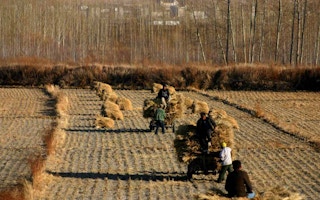Deadly heatwaves could kill people working outdoors within hours in China’s most populous, agricultural region by 2100 as a result of climate change, scientists said on Tuesday.
The North China Plain, home to 400 million people, faces the greatest risk to human life from rising temperatures of any location on earth, the Massachusetts Institute of Technology (MIT) said in the journal Nature Communications.
“Climate change is going to trigger deadly heatwaves,” lead researcher Elfatih Eltahir told the Thomson Reuters Foundation.
“The intensity of those heatwaves means that survival of humans would be questionable.”
The World Health Organization says heat stress, linked to climate change, is likely to cause 38,000 extra deaths a year worldwide between 2030 and 2050.
People cannot survive unprotected in the open for more than six hours at a wet-bulb temperature - which reflects the combined effects of heat and humidity—of 35 degrees Celsius (95°F), the study said.
“
The intensity of those heatwaves means that survival of humans would be questionable.
Elfatih Eltahir, lead researcher, Massachussetts Institute of Technology
This is because their bodies cannot shed heat, as sweat does not evaporate when it is very humid, which can lead to organ failure.
Unless climate-changing emissions are curbed, the deadly 35-degree threshold will be reached several times in the North China Plain between 2070 and 2100, the study found by running climate model simulations.
“The North China Plain … faces the greatest risks to human life from rising temperatures of any location on Earth,” MIT said in a statement.
Heatwaves have already increased in the North China Plain, MIT said, comparing its agricultural role to that of the Midwest in the United States, topping 38 degrees Celsius in 2013.
“Poor people who don’t have access to air conditioning, like farmers, and can’t afford the luxuries of modern life … those conditions will be very tough on them,” Eltahir said.
About 1.1 billion people in Asia, Africa and Latin America are at risk from a lack of air conditioning and refrigeration to keep them cool and to preserve food and medicines as temperatures rise, a study said this month.
This story was published with permission from Thomson Reuters Foundation, the charitable arm of Thomson Reuters, that covers humanitarian news, women’s rights, trafficking, property rights, climate change and resilience. Visit http://news.trust.org)










